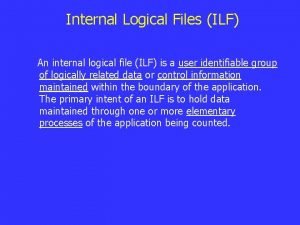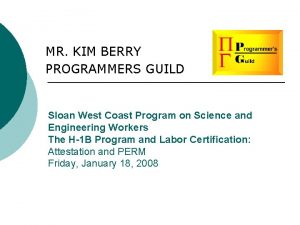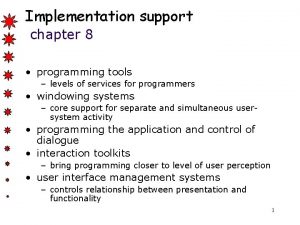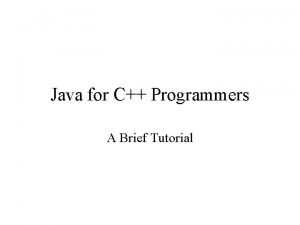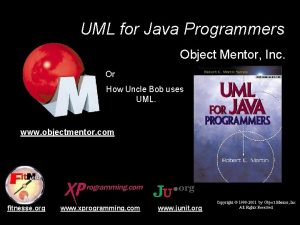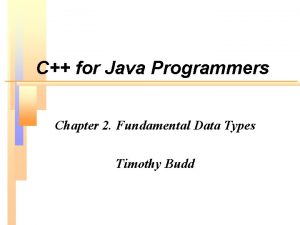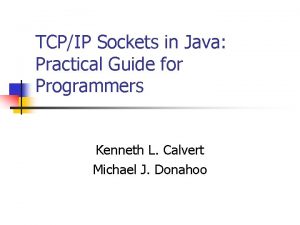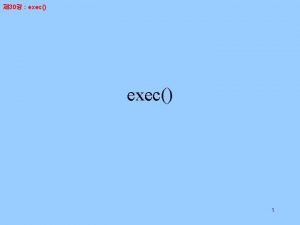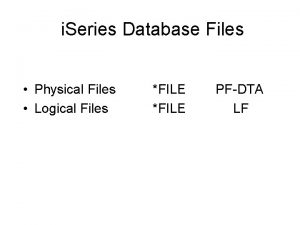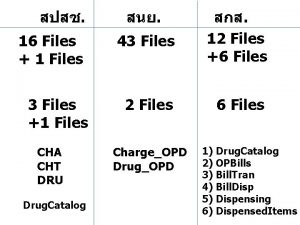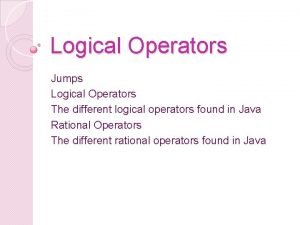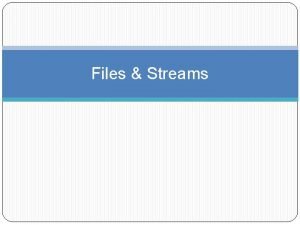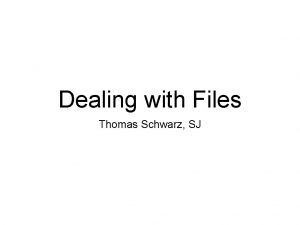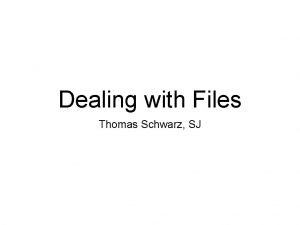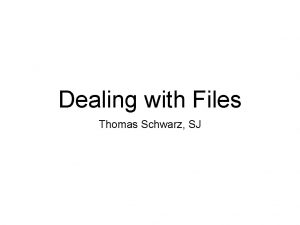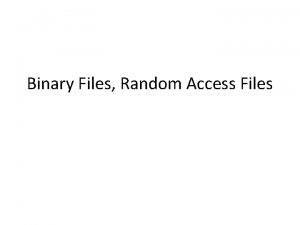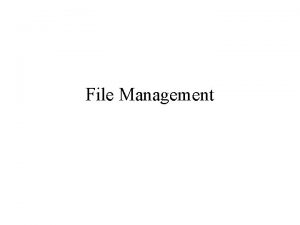Programmers View of Files Logical view of files

![Java File Functions Random. Access. File(String name, String mode) close() read(byte[] b) write(byte[] b) Java File Functions Random. Access. File(String name, String mode) close() read(byte[] b) write(byte[] b)](https://slidetodoc.com/presentation_image_h2/77d7505edbd655713de159a9b6c56395/image-2.jpg)













- Slides: 15

Programmer’s View of Files Logical view of files: – An a array of bytes. – A file pointer marks the current position. Three fundamental operations: – Read bytes from current position (move file pointer) – Write bytes to current position (move file pointer) – Set file pointer to specified byte position.
![Java File Functions Random Access FileString name String mode close readbyte b writebyte b Java File Functions Random. Access. File(String name, String mode) close() read(byte[] b) write(byte[] b)](https://slidetodoc.com/presentation_image_h2/77d7505edbd655713de159a9b6c56395/image-2.jpg)
Java File Functions Random. Access. File(String name, String mode) close() read(byte[] b) write(byte[] b) seek(long pos)

Primary vs. Secondary Storage Primary storage: Main memory (RAM) Secondary Storage: Peripheral devices – Disk drives – Tape drives – Flash drives

Comparisons Medium 1996 1997 2000 2004 2006 2007 2008 RAM $45. 00 7. 00 1. 500 0. 3500 0. 1500 0. 0742 0. 0339 Disk 0. 25 0. 10 0. 0010 0. 0005 0. 0004 0. 0001 Flash ----- Floppy 0. 50 0. 36 0. 2500 ----- Tape 0. 03 0. 01 0. 0003 ----- 0. 1000 0. 0900 0. 0098 0. 0029 RAM is usually volatile. RAM is about 1/2 million times faster than disk.

Golden Rule of File Processing Minimize the number of disk accesses! 1. Arrange information so that you get what you want with few disk accesses. 2. Arrange information to minimize future disk accesses. An organization for data on disk is often called a file structure. Disk-based space/time tradeoff: Compress information to save processing time by reducing disk accesses.

Disk Drives

Sectors A sector is the basic unit of I/O.

Terms Locality of Reference: When record is read from disk, next request is likely to come from near the same place on the disk. Cluster: Smallest unit of file allocation, usually several sectors. Extent: A group of physically contiguous clusters. Internal fragmentation: Wasted space within sector if record size does not match sector size; wasted space within cluster if file size is not a multiple of cluster size.

Seek Time Seek time: Time for I/O head to reach desired track. Largely determined by distance between I/O head and desired track. Track-to-track time: Minimum time to move from one track to an adjacent track. Average Access time: Average time to reach a track for random access.

Other Factors Rotational Delay or Latency: Time for data to rotate under I/O head. – One half of a rotation on average. – At 7200 rpm, this is 8. 3/2 = 4. 2 ms. Transfer time: Time for data to move under the I/O head. – At 7200 rpm: Number of sectors read/Number of sectors per track * 8. 3 ms.

Disk Spec Example 16. 8 GB disk on 10 platters = 1. 68 GB/platter 13, 085 tracks/platter 256 sectors/track 512 bytes/sector Track-to-track seek time: 2. 2 ms Average seek time: 9. 5 ms 4 KB clusters, 32 clusters/track. 5400 RPM

Disk Access Cost Example (1) Read a 1 MB file divided into 2048 records of 512 bytes (1 sector) each. Assume all records are on 8 contiguous tracks. First track: 9. 5 + (11. 1)(1. 5) = 26. 2 ms Remaining 7 tracks: 2. 2 + (11. 1)(1. 5) = 18. 9 ms. Total: 26. 2 + 7 * 18. 9 = 158. 5 ms

Disk Access Cost Example (2) Read a 1 MB file divided into 2048 records of 512 bytes (1 sector) each. Assume all file clusters are randomly spread across the disk. 256 clusters. Cluster read time is 8/256 of a rotation for about 5. 9 ms for both latency and read time. 256(9. 5 + 5. 9) is about 3942 ms or nearly 4 sec.

How Much to Read? Read time for one track: 9. 5 + (11. 1)(1. 5) = 26. 2 ms Read time for one sector: 9. 5 + 11. 1/2 + (1/256)11. 1 = 15. 1 ms Read time for one byte: 9. 5 + 11. 1/2 = 15. 05 ms Nearly all disk drives read/write one sector (or more) at every I/O access – Also referred to as a page or block

More Recent Drive Specs • • Samsung Spinpoint T 166 500 GB (nominal) 7200 RPM Track to track: 0. 8 ms Average track access: 8. 9 ms Bytes/sector 512 6 surfaces/heads 15
 Cjis meaning
Cjis meaning File mode python
File mode python Ncic restricted files
Ncic restricted files Internal logical files examples
Internal logical files examples Logical form and logical equivalence
Logical form and logical equivalence Logical form examples
Logical form examples Programmers guild
Programmers guild Implementation of uims
Implementation of uims Java for c programmers
Java for c programmers Object mentor
Object mentor C for java programmers
C for java programmers Tcp/ip sockets in java: practical guide for programmers
Tcp/ip sockets in java: practical guide for programmers Linux programmers manual
Linux programmers manual Programmers use backdoors to debug and test programs.
Programmers use backdoors to debug and test programs. Cse 2431
Cse 2431 Logical view uml
Logical view uml



